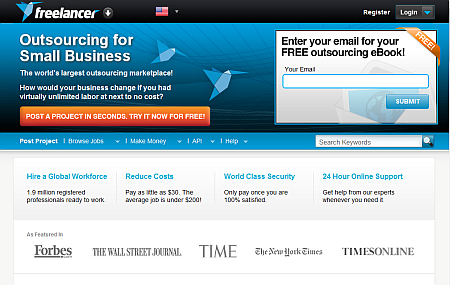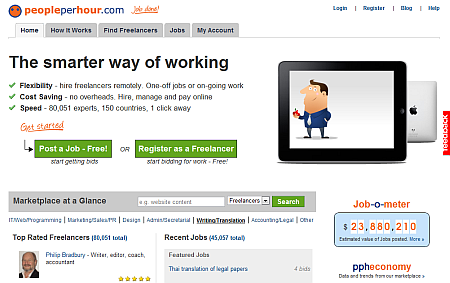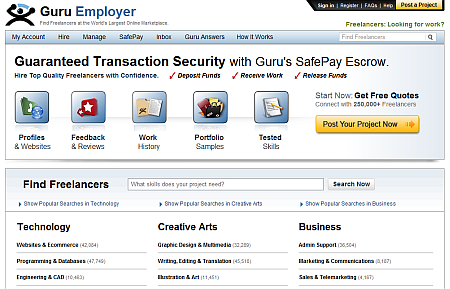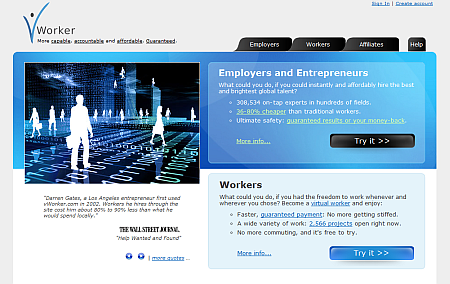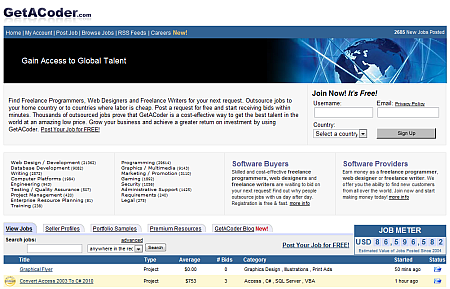Guidelines For Outsourcing, Sub-Contracting and Hiring Out
From one artist to another, I know how satisfying it can be to achieve the perfect shade of a color or squeeze the most difficult font into the funkiest space.
Having spent some time experimenting with these and other aspects of design, I also know how time-consuming and downright maddening it can be to do these things without enough know-how. Fortunately, there’s an easier way to solve design problems, and I wish I discovered it much earlier.
Further Reading on SmashingMag:
- Lessons Learned From A First-Time Appreneur
- Freelance Contracts: Do’s And Don’ts
- The Collective Legal Guide For Designers (Contract Samples)
Outsourcing, sub-contracting, hiring it out: whatever you want to call it, it’s a designer’s best friend and a dirty little secret at the same time. Outsourcing not only solves design problems, it solves them cheaply, while you go off to do the things that you really want to do. Here’s how to do just that.
Outsourcing Through A Scope
You can outsource anything that can be transmitted over the Internet, including:
- original artwork;
- animation and video;
- photography;
- pictures for books, magazines and other publications;
- stationery, greeting cards, calendars, and patterns for textiles and wrapping paper;
- storyboards for television commercials, movies and animated features;
- sketches;
- PowerPoint presentations;
- magazine, newspaper and journal articles;
- corporate report layouts;
- marketing brochures;
- company logos;
- even boring business stuff, like cleaning spam from your inbox.
Let’s say you want to outsource something you just don’t have time for anymore. And let’s say that “something” is splicing up a bunch of images for a hundred different websites. To get started, itemize each individual task for that project to produce a project scope.

Losing track of tasks? (Image: Torley)
In outsourcing, a scope lays out the required services, limitations, locations, provisions and exclusions. The more details, the better. One of the biggest problems when outsourcing online is failing to provide enough specifics, which leaves service providers guessing what’s needed.
What It’s Gonna Cost Ya?
So, how much does it cost to splice up a hundred different images anyway? How much does it cost to transform a plain HTML website into a glossy Web 2.0 showcase? These are great questions, and they can be answered from two angles.
Your Own Costs

What’s it going to cost you? (Image: Andrew Magill)
The first way is to get a good sense of the number of hours involved, and put a dollar figure on those hours. You could then either pay minimum wage or pay a fee close to the costs of those tasks at your place of employment.
What Others Cost
The second way is to snoop around outsourcing services and note what the higher-end providers charge for work similar to what you want done. Highly rated service providers will essentially tell you two things: what is this stuff actually worth, and what are other people paying for the service? The answers will help you establish an appropriate rate.
Whatever approach you take, don’t forget to tack on website fees. Some outsourcing services add a fee or percentage on top of what you’re prepared to pay.
What If…?

Do you want to take the risk? (Image: It’sGreg)
Reasonable Expectations
It’s important to note that the online environment doesn’t shield outsourcers from complications. In fact, the Internet has created new problems. I’m talking about email failures, Internet disconnections, downed websites, virus attacks, etc.
Be diligent about opening file attachments. You might need a back-up ISP to ensure that you can communicate at scheduled times and meet deadlines. If you will be hosting your own website, you’ll need a back-up server and strong up-to-date anti-virus software.
You’re equally vulnerable to other risks: intellectual property theft, contract breaches, data loss, bankruptcy, illness, death and natural disasters. Language barriers, ignored job proposals, incompetence in the service provider and lost arbitration are risks as well.
Reasonable Precautions
You can’t prevent all problems, but you can usually plan for or work around them. You can’t prevent someone from stealing your proprietary information, but you can certainly seek compensation in court. You can’t physically force someone to commit to a contract, but by keeping in mind a few back-up providers, you can minimize the impact of a no-show or deserter.
You’re a Risk, Too
That’s right. Micromanagement, impatience, unprofessional behavior and unwillingness to commit are potential project killers, so put outsourcing on the back burner if you’re prone to these types of behaviors. Outsourcing leads to a relationship that needs tending, just like any other relationship.
Your role as a conscientious outsourcer is to minimize the potential damage caused by potential problems. Consider the consequences of each risk, and then plan a course of action that would lessen its impact.
Just Ones And Zeros

Keep one eye open, always! (Image credit: We Love Costa Rica)
Contracts Rule!
Contracts, while not foolproof, can reduce and even eliminate some of the risks described above. Here’s what every outsourcing contract worth its salt should address:
- Working relationship,
- Services to be rendered,
- Terms of agreement,
- Payment terms,
- Confidentiality,
- Dispute resolutions,
- Contact information.
The worst thing you could do is outsource without a contract. Sure, contracts are just pieces of paper (or ones and zeros), but without one, you won’t have a leg to stand on should you decide to legally enforce your agreement. Some outsourcing services expect you to drum up your own contract, while others provide their own full documents and include provisions that you might not have even thought of. I strongly recommend using a service that does the latter.
The Non-Disclosure Agreement
There might come a time when you need an agreement that describes the conditions under which confidential information may be accessed, used and shared. This is called a non-disclosure agreement (NDA), and samples can be found online with minimal searching. Most outsourcing services provide a way to append contracts with NDAs.
Think Time, Money, Model.

Reach your potential! (Image: Tumitu Design)
If you look at my reviews of the top 10 outsourcing services further down in this article, you’ll see a section for job models, which breaks down as either fixed fee or per hour. Here’s what you need to know about each.
Fixed Fee
A fixed-fee job is a project completed for one lump sum. It’s the perfect solution when you have a huge project, don’t know how long it’s going to take to finish and don’t want to pay more than a set amount. A graphics-intensive college website would be suitable for the fixed-fee job model, especially if it’s database-dependent and laden with crazy ASP code.
Per Hour
A per-hour job is a project that’s paid for one hour at a time. It’s the right choice when you’re low on funds and need a quick, cheap solution for a small project. A simple 64 × 64-pixel icon design would be suitable for the per-hour job model. Some jobs take longer to complete than others, so think about the time, money and model. Then look at the services covered furthered down to find a good match.
Ideal Bids And Ratings
If you haven’t thought about how you’ll handle bids, now is as good a time as any. The Internet has facilitated the bidding process and hurried it to a speed beyond belief, so plan ahead!
What’s the Ideal Bid?
Prevent an overload of irrelevant responses by crafting an ideal bid of your own before publicizing the job. In your posting, list the specific issues that each bidder should address in their bid, identify your budget, and provide specific instructions on how bids should be formatted. Include price and delivery estimates as well. For each bid that trickles into your inbox, match the points to the items in your notes to find feasible matches.
Ratings and Feedback
Verify the quality of a bidder by reading online ratings of their service. Don’t put too much stock in them, though: on websites that don’t have a double-blind rating system, the outsourcer and the service provider can see the other’s rating, and one of them might have retaliated with undeserved negative feedback.

Opinions make a difference. (Image: FindYourSearch)
Supplement your reading of ratings by browsing the bidder’s work history. Get a sense of who you’ll be dealing with, and look for positive feedback on jobs similar to what you want done. If you aren’t comfortable with what you see, move on to the next until you find a few workable candidates.
Must-Haves
Once you’ve found a few bidders whose proposals make sense and whose feedback is genuinely promising, engage them in further discussion to determine which bidder is most suitable. The outsourcing service you use should make the hiring process simple, and that process looks pretty much the same across the board.
When it comes to managing the working process, though, you’ll be on your own. Here’s what you must have.
A List of Milestones
If the project is big, use milestones to measure progress, catch potential problems and take corrective action. A corrective action can range from fixing a flaw to cancelling the project if it’s beyond repair.
Two easy milestone systems I recommend are date-based and phase-based. The date-based system checks a project at certain intervals. The phase-based system checks a project at transition points, between one phase and the next.
In both systems, the provider would file status reports of some kind, detailing the work they’ve completed. Service providers aren’t always expected to mark milestones, though, so you might need to demand them in your contract.
A Record of Payments
You may wish to pay the provider upon successfully reaching each milestone, so keep records of your transactions. Record-keeping prevents overpayment, underpayment and outright non-payment. Your outsourcing service of choice should provide a way to do this, but if it doesn’t, use a simple spreadsheet to note what was paid for, when it was paid and the amount.
Documentation
Documenting your outsourcing adventures accomplishes two important things. First, it creates a diary of personal do’s and don’ts. Whenever you wish to evaluate how well (or poorly) you have performed as an outsourcer, you can find it in your documentation. One of the great things about outsourcing through an online service is that it automatically logs and documents everything for you.
Secondly, it creates a record of who screwed what up, which is extremely important in the event of a dispute. To support your case in an arbitration, for example, you’d need a record of conversations that can be verified by the powers that be (i.e. the service provider’s arbitrators). Documentation includes all email messages, chat logs, message board postings and anything else that could act as a buffer between you and your hired gun.
Speaking of which…
The Last Thing You Want
Arbitration is the hearing and determination of a contract dispute by a referee. It protects you from monetary losses, and it can be exercised for a number of reasons, ranging from simple disagreements to outright contract violations.
Yet this too varies from outsourcing service to outsourcing service. One might offer arbitration for all types of jobs, for only certain jobs or, worse, for no jobs whatsoever. Avoid services that don’t offer arbitration.
Even though arbitration is usually the last thing you want, it’s comforting to know that it’s available if you need it. You might need it if your service provider does any of the following (although this list is not exhaustive):
- Turns in low-quality work,
- Misses a critical deadline,
- Uses third-party material without your permission,
- Makes insufficient progress in reaching a milestone, and you simply want out.
Under no circumstances should you feel obliged to pay for an experience that wasn’t what you expected. That’s when contracts, escrow and communication play their strongest roles. Use them to reinforce your decision to withhold payment, and request arbitration to get the provider to comply with the contract or to terminate the contract altogether.
Outsourcing Outlets
The following online services, listed in order of market share (according to WhichLance’s “Freelance Marketplace Review: Quarter 2, 2010”), are among the most popular outlets for outsourcing.
oDesk [Update, 22.6.15: Now “Upwork”]:
- Fees: 10% of each project
- Job model(s): fixed fee fnline services, listed in order of market sh and per hour
- Escrowing: available for per-hour projects only
- Arbitration: not available
- Guarantee: available for per-hour projects only
- Ratings system: allows service providers to hide bad feedback
- Fees: $10 to create an account
- Job model(s): fixed fee and per hour
- Escrowing: available for fixed-fee and per-hour projects
- Arbitration: costs $66 to $133.33 for fixed-fee and per-hour projects
- Guarantee: available for per-hour projects only
- Ratings system: does not use a double-blind ratings system
- Fees: $5 to post a project, plus 3% of the project to select a provider (plus 10% tax applied to Australians)
- Job model(s): fixed fee and per hour
- Escrowing: available for fixed-fee and per-hour projects
- Arbitration: available for fixed-fee projects with milestone payments of more than $30
- Guarantee: available for fixed-fee projects only
- Ratings system: uses a double-blind ratings system
- Fees: 1.9% to 3.9% of a project in payment processing charges
- Job model(s): fixed fee, per hour and commission-based
- Escrowing: available for fixed-fee and per-hour projects
- Arbitration: available for fixed-fee and per-hour projects
- Guarantee: available for fixed-fee and per-hour projects
- Ratings system: does not use a double-blind ratings system
- Fees: $5 to select a service provider
- Job model(s): fixed fee and per hour
- Escrowing: available for fixed-fee and per-hour projects
- Arbitration: not available
- Guarantee: not available
- Ratings system: does not use a double-blind ratings system
- Fees: $0 to $20 payment processing charge
- Job model(s): fixed fee and per hour
- Escrowing: available for fixed-fee and per-hour projects
- Arbitration: costs 33% of project for fixed-fee and per-hour projects
- Guarantee: available for fixed-fee and per-hour projects
- Ratings system: does not use a double-blind ratings system
Note: LimeExchange is sixth in market share but is set to close down this year.
Guru:
- Fees: none
- Job model(s): fixed fee and per hour
- Escrowing: available for fixed-fee and per-hour projects
- Arbitration: available for fixed-fee projects
- Guarantee: available for fixed-fee projects only
- Ratings system: allows service providers to hide bad feedback
- Fees: none
- Job model(s): fixed fee and per hour
- Escrowing: available for fixed-fee and per-hour projects
- Arbitration: freely available for fixed-fee and per-hour projects
- Guarantee: available for fixed-fee and per-hour projects
- Ratings system: uses double-blind ratings system
GetACoder:
- Fees: none
- Job model(s): fixed fee and per hour
- Escrowing: available for fixed-fee and per-hour projects
- Arbitration: available for fixed-fee and per-hour projects
- Guarantee: implied for fixed-fee and per-hour projects
- Ratings system: does not use a double-blind ratings system
- Fees: none
- Job model(s): fixed fee
- Escrowing: not available
- Arbitration: not available
- Guarantee: not available
- Ratings system: does not use a double-blind ratings system
Etiquette: Do’s And Don’ts
- Don’t accept (or pay for) work that you’re not satisfied with. Doing so not only misleads providers into thinking that their work is on par, but it lowers the bar for quality online outsourcing.
- Don’t ask for a high-quality product to be done in a matter of minutes. You wouldn’t want such a demand to be made of you, so please don’t ask for the impossible from others.
- Don’t let one bad apple spoil the whole barrel. Some outsourcers discredit the entire industry because of one unpleasant experience. That’s unfair to hard-working designers.
- Don’t try to trick an amateur service provider into providing something that they didn’t agree to. That’s grounds for arbitration, which is as much a possibility for them as it is for you.
- Do pay on time. If providers learn that you’re slow to pay for work rendered (and they do talk to one another), they could shy away from working for you.
- Don’t dismiss new providers. A provider with little to no real-world experience might come up with just the solution you’re looking for.
- Do relax and refresh yourself before evaluating work. Testing deliverables when you’re tired, distracted or rushed will cause you to overlook important project requirements.
- Do remember netiquette. “Please” and “thank you” are always “welcome.”
- Don’t guarantee a good rating in exchange for a low quote. Doing so negates the ratings system, which is supposed to enforce work quality, not low prices.
- Don’t change or increase requirements mid-development. Throwing unexpected work into the mix is a disruption that providers don’t like and legally don’t have to accommodate.
- Don’t micromanage. To micromanage is to excessively and needlessly pester a provider for work or feedback. If you incessantly bug a provider with trivial issues, you’ll delay or even derail the project.
- Don’t overwork a service provider. Steady work is fine for providers who can handle it (it’s appreciated, in fact), but inundating a provider with work without granting proper rest periods is not. Put yourself in their shoes, and think about how important breaks are.
- Don’t promise future work in exchange for a product or service. Anything can happen after a promise has been made, and if an unforeseen problem makes it impossible to grant that work, the outsourcer will develop a reputation for untrustworthiness.
- Do pay fairly. If you exploit providers by paying lower than minimum wage, you’ll gain an unfavorable reputation and ruin your chances of attracting quality providers later.
- Do give a provider who you don’t know a small inexpensive test project, and see how it goes before hiring them for a large expensive project.
- Do provide samples of what you’d like the provider to accomplish. Everyone appreciates having a base concept to start from, so feel free to send sketches of what you want (no matter how bad your drawing skills might be).
- From a vWorker staff member: never insult a designer’s work. Remember that different people with different styles and of different ages and cultures have different perspectives on what’s nice, appropriate, professional and clean.
Don’t Stop Here. Go!

Keep going! (Image: B Tal)
For the most part, outsourcing online is a positive experience. Given its high success rate, it’s difficult to argue otherwise. That’s why I’m standing behind you and pushing you to explore this solution. In fact, if you don’t put your head out there and try it, you could hold yourself back.









